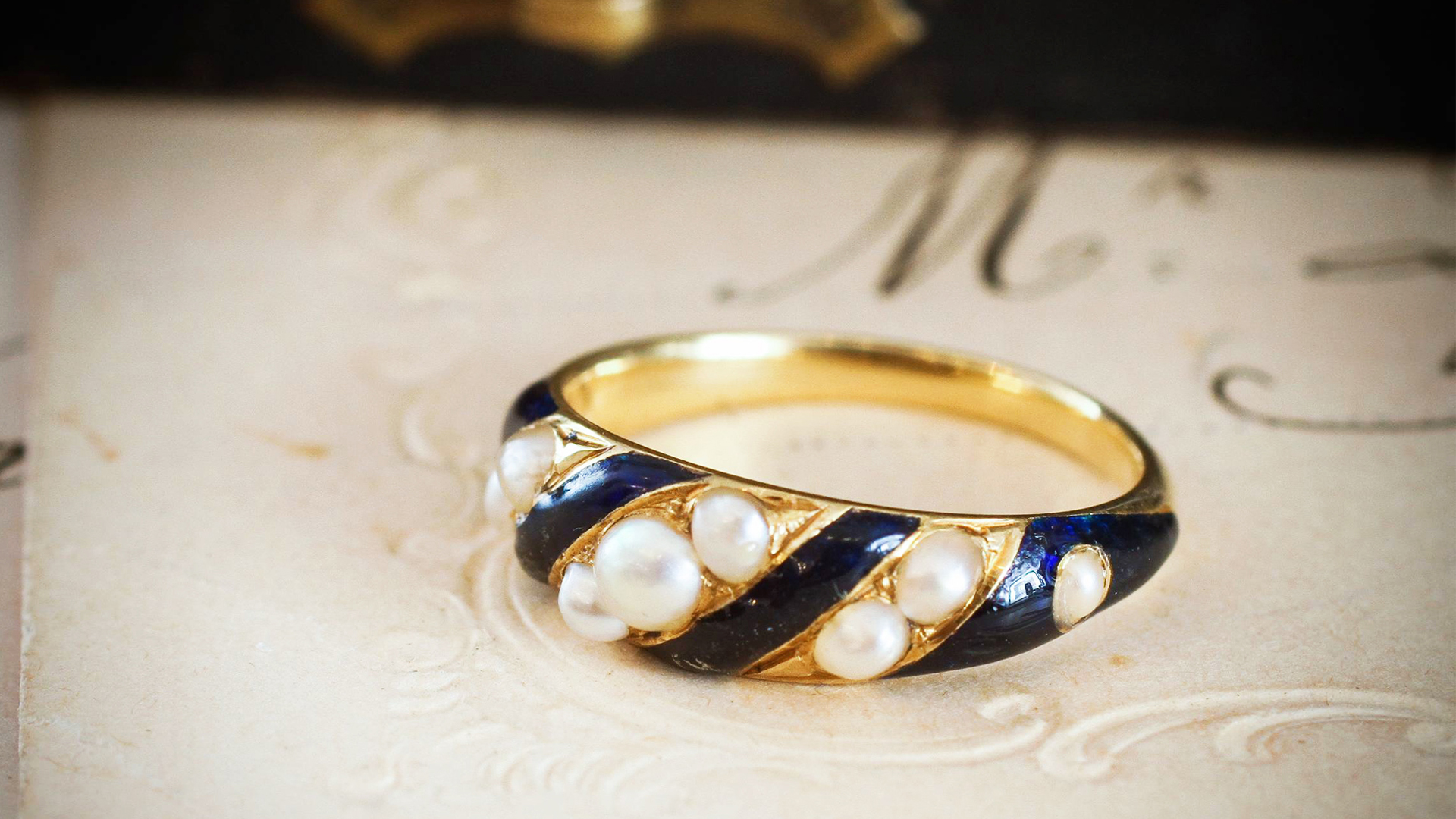As Valentine’s Day is quickly approaching, I want to introduce to you a jewelry style that was created to openly celebrate love: Victorian Sentimental Jewelry.
Let’s put things in their context: the Victorian period — named after Queen Victoria, who reigned over the United Kingdom of Great Britain and Ireland — expanded roughly from 1837 to 1900, simultaneous to her reign.
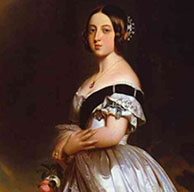
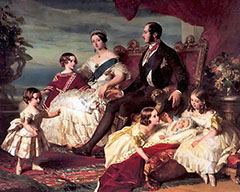
Upon her ascension on the throne in 1837, the backdrop in Europe was Romanticism: a literary and artistic movement that expanded on music, visual and decorative arts, fashion and jewelry.
In Victorian Great Britain, the Queen’s influence was palpable on everything, including jewelry design. The people of England followed her passionate romance with her husband Prince Albert and joined her in mourning after his death in 1861. She made it fashionable to wear jewelry that revealed your feelings, be it love or grief: if at the beginning of her reign the ideas of marital joy, family life, sentiments and courtship were celebrated; things took a darker turn in the second half of the century.
Everything was worthy of commemoration: happy moments as well as sad ones. That is why we also see a lot of memento pieces. Now let’s dive into this fascinating world and learn about one of the most significant movements of jewelry history!
Symbols in Victorian sentimental jewelry
Victorians loved using symbols, specially in love affairs.
The classic symbols of love that we also see today were largely used in Victorian sentimental Jewelry. Hearts, lovebirds, lover’s knots, Cupid’s arrow, keys, holding hands… this kind of pieces were very commonly gifted to a love interest. Specially bowed double hearts were very popular. Portraits were also incorporated in jewelry and pieces carrying lovers’ portraits were common gifts. In some cases, we could also see Lover’s Eye pieces (coming from the Georgian Period), where only the loved one’s eye was painted — usually to protect the secrecy of the love affair.
Most of the jewels carried script engraving with a personalized message – or name/date – in their inner side.
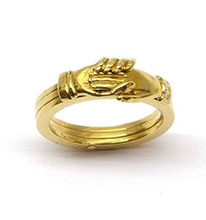

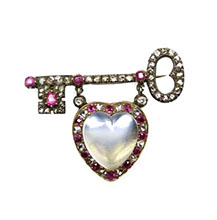
Hidden Messages
Secret messages were transmitted in jewelry using different codes. These codes could be either specific motifs (like the previously mentioned loved themed symbols), gemstones words, or the language of flowers.
The language of flowers
The Victorians were very fond of flowers and gardens. Botanicals were in fashion and were present in jewelry as well. Floral motifs were added to all kind of pieces for extra meaning and sentiment. Different flowers were used to communicate one’s feelings: tulips & roses (love), lilies (purity), forget-me-nots (remembrance), violets (faith), pansies (think of me), orange blossoms (everlasting love).
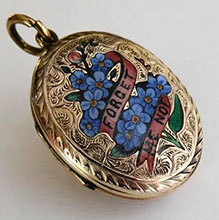

10k gold & enamel Victorian lily locket

Remembrance ring: Engraved gold body, oval amethyst set with gold forget-me-not, rose cut diamond, 1876.
Gemstone words
Another popular form of transmitting hidden messages in Victorian sentimental jewelry was making acrostics using gemstones. This type of jewelry is also known as Acrostic jewelry. Brooches, charms and rings were set with a variety of gemstones whose first letter was secretly spelling out the sentiment we wanted to transmit to the person.
- The most common sentiments written in stones included:
“Regard” spelled with Ruby, Emerald, Garnet, Amethyst, Ruby and Diamond; - “Love” spelled with Lapis-lazuli, Opal, Vermeil and Emerald;
- “Dearest’ with Diamond, Emerald, Amethyst, Ruby, Emerald, Sapphire and Topaz.
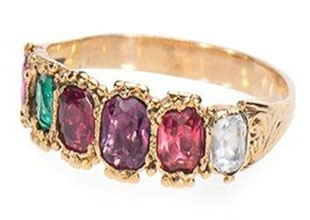
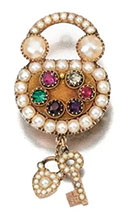
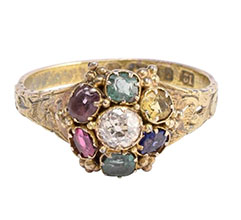
Hair Jewelry
One of the earliest forms of sentiment in jewelry history, dating back to ancient times, was hair jewelry. It reached the epitome of its popularity during the Victorian era, with the help of the Queen herself. Giving a small lock of your hair to your lover or a family member, often in a piece of jewelry, for them to wear or cherish as a sentimental souvenir was very common. All kind of pieces could feature hair: rings, pins, lockets, pendants, bracelets and watches. Sometimes the piece was entirely made of braided hair. That was the most popular gift between long-distance lovers – men leaving often for wars.

9k gold Victorian bracelet, 1860’s. The body is made of braided hair; Removable cameo portrait on the front.

Inside the buckle, a script engraving shows us this piece was a gift from a family member.
Teeth Jewelry
That may sound creepy to us today, but you read right! Teeth jewelry was a common thing. Mothers would wear pieces that have their children’s milk teeth on them. Child mortality being very high back then (50%), it was surely something to celebrate when your kids reach the age of tooth transition. Prince Albert himself offered Queen Victoria a brooch featuring their eldest daughter’s milk tooth. Once again, the queen was the trend-setter! It was also common to incorporate hunted animal teeth into jewelry. Those were called mementos: pieces that commemorate a certain event of one’s life.

Memento: The milk tooth of Princess Vicky was inserted into a brooch.

Mourning Jewelry
Mourning jewelry represents a big part of sentimental jewelry. These pieces were commissioned to jewelers after a loved one’s death, and worn in their memory. They often carried the deceased person’s hair, sometimes combined with a cross and forget-me-nots, and often their date of death or a small quote. Many of these pieces feature black enamel or black onyx stones.
One of the reasons of the popularity of mourning jewelry was the numerous infant deaths and husbands dying at wars. Heartbroken wives and mothers, along with wearing only black for years, turned to this type of jewelry as a sign of remembrance.

Late Victorian gold Locket Mourning Brooch for Ian Douglas Montagu, with diamonds, black enamel and pearls.


Black onyx & porcelain mourning locket with a portrait and hair of the deceased inside.
Jewelry in the second part of the 19th century took a darker form: after the death of Queen Victoria’s Mother and husband, the monarch turned to mourning and her grieving subjects followed her example.
It became a fashion to wear your grief and the demand for custom mourning jewelry exploded. Dark colors such as black (early stages of mourning) and later on gray or mauve were used. As for the materials; the most commonly used were jet, onyx, vulcanite, as well as some dark woods.
Memento Mori
Memento mori (reminder of death in Latin), or memorial jewelry, are more simple pieces, only featuring a date, name, cross, forget-me-not flowers etc. They became in vogue during the 1880’s and most often characterized by the use of enamel.

“Memento Mori” band “Sarah·Lillyman·died·3·nov·1780 aged·68”.
We clearly see that the Victorian era very rightfully took its name from Queen Victoria. She truly set the tone of the century dependently on the events of her life. Her influence also reflected on fashion and jewelry design: the beginnings echo her youth, courtship, happy marriage and loving family life with sentimental and joyful pieces; while the last decades reflect her intense mourning and the rituals that go with it.
The 19th century left us countless pieces that carry endless love stories, lovers’ passion, happy mothers’ and wives’ affection, as well as their pain when they lost their significant ones.
www.doyledoyle.com
www.joyjonesjewelry.com
www.wikipedia.com
www.jewelsdujour.com
www.instagram.com/_butterlaneantinques
Cover image: www.fetheray.com
© 2021 Paola Sleiman. All rights reserved.

